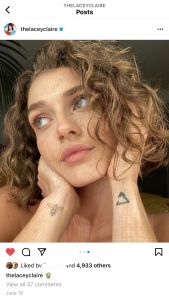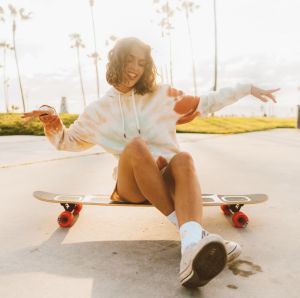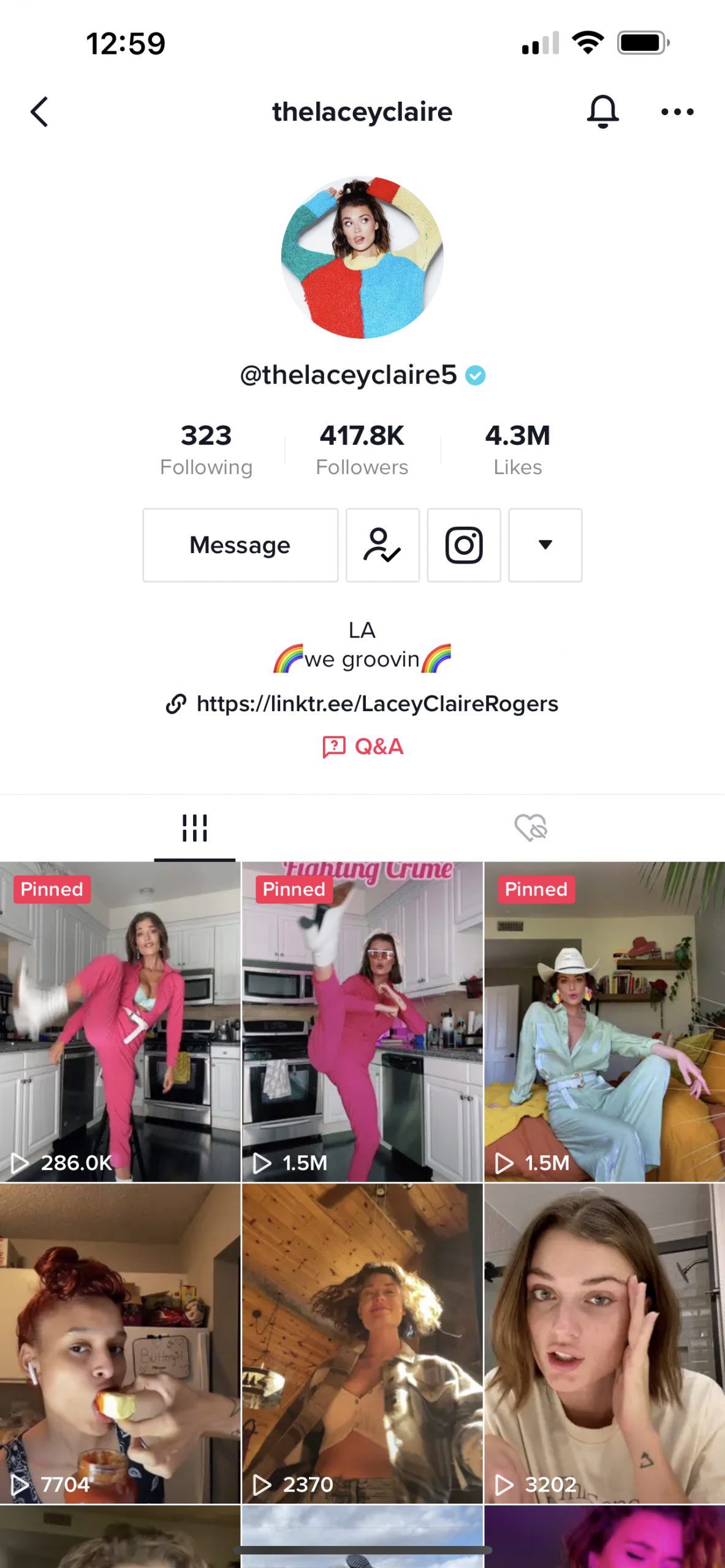17-years-old, sitting at a desk in high school, jotting down what she wanted her hometown photoshoots to look like.
Today, she has over 310,000 Instagram followers.
Lacey Claire Rogers grew up in a small town in Arkansas with a passion for creating.
“I started taking photos with one of my childhood best friends because he told me I was photogenic and that my Instagram feed was strong,” Rogers said. “This was in 2013, close to when Instagram just launched.”
Instagram launched in 2010, but when Facebook acquired it in 2012, its popularity really took off. Statista reports that Instagram has around one billion active users worldwide.
Her friend wanted to start a photography business in their town and asked for her help. They started doing photoshoots together.
“I didn’t know creative direction was a thing, let alone a job but that was exactly what I was doing,” Rogers said. “I would sit in class and write down on a piece of paper what I wanted the makeup to look like, props I wanted, I would get inspired by clothes and location.”
Rogers would drive around to find locations they could shoot at. She credits working with her friend as what taught her to model, create and produce, as she was able to begin to help him with his clients.
“After that, I got discovered on Instagram to go on America’s Next Top Model and that’s what kind of launched everything for me,” Rogers said.
Rogers was on Cycle 22 of America’s Next Top Model, placing third in the overall competition. She was still a senior in high school at the time and during the last quarter of her senior year, she flew to Los Angeles to film the show for two months.

“That was such a fun experience, being on set everyday, and I was the youngest in the house, I was 18,” Rogers said. “I was able to convince my parents to let me move to LA, saying that being on the show was my sign.”
Right after the show wrapped, she flew home. A week later she graduated high school and two weeks after that she moved to Los Angeles into a studio apartment.
“At that point in my life, I was going to community college and just modeling,” Rogers said. “That’s what I was doing for a while, but I entered this realm right as influencers became a thing. I entered right before influencers even had the term influencers.”
Rogers remembers moving to LA and no one knew what a paid sponsored post was and companies didn’t have marketing dollars to give to influencers yet.
“At the time, that was still so new,” Rogers said. “Now, if you have a company, you most likely have a budget for influencer marketing.”
Despite her online persona being strong and beautiful, Rogers was recovering from an eating disorder.
The National Eating Disorders Association reports that even though there is no single cause of eating disorders, research shows that social media contributes to body dissatisfaction and eating disorders.
Last month, the Wall Street Journal published an article discussing how Facebook is fully aware of Instagram’s negative effect on girls’ self-image. Despite Facebook’s awareness, they do not address the problems and downplay them in public.
“I think social media played a factor in my eating disorder,” Rogers said. “I would have people comment on my posts saying how skinny I was and how they wanted to have my body, and in my brain, I was telling myself that if I become skinnier, I’ll become prettier.”
As she was recovering, things in modeling started to fall out.
“I wasn’t a working model, and even today, I’m not one of those,” Rogers said. “I want to be on a set every day and I’m just not. Luckily, with social media, there was money and security in that.”
Rogers tried out social media for a while, becoming friends with Jake Paul’s Team 10 crew and trying to be a vlogger and YouTuber but she found it was very “cringey.”
As she was trying to figure out the social media world, Rogers found herself posting about products that she hadn’t used before, which made her question what she was doing.
“I was lying to people and what’s the point in that,” Rogers said. “I was very concerned with how people perceived me and I was also like, ‘what is my purpose? This doesn’t make me fulfilled at all.’”
Because of that, Rogers experienced depression. She was also unable to find friends within other models or within the influencer community who she found “very shallow.” This sparked something in Rogers that drove her to do more.
“I wanted to turn my life around and I ended up getting an internship because I never had a ‘real job’ before,” Rogers said.
Rogers found herself working at a wine company for two years doing sales.
“That taught me so much about work culture and how to do Excel spreadsheets and how to take no for an answer,” Rogers said. “It taught me to be determined, how to make relationships and how to be a hard, good worker and I really appreciated that.”
At the beginning of COVID, the company let her go and she became concerned with what she was going to do because she didn’t want to become depressed again and just sit at home. Her manager was there to help her along the way, which kept her motivated.
“Over quarantine, I really found my love for creating again,” Rogers said. “When I was in that dark spot of my life, it felt pointless and conceited. I was scared of judgment and not fitting in and I didn’t know how being a creator seemed to people. I would lie to people about being an influencer or content creator. I used to think they thought so negatively of someone who does that as a job.”

In a study done in 2020, 63 percent of social media users said they find the content created by social media influencers to be more compelling than scripted advertising written by a marketing professional. They found that influencer marketing has become accepted and effective.
“It depends on who you’re surrounded with if people still don’t take being an influencer or content creator as a real job,” Rogers said. “I want to say people are more accepting, but that’s also the community that I run with.”
Rogers was glad the internship had laid her off since she was able to find new ways to create, whether it’s on a small or big scale.
“Even though the things I do on Tik Tok are so goofy and mindless, it’s fun for me,” Rogers said.
Rogers has since taken more control over what she puts on social media, not relying on ads for income as much anymore.
“Now, for Instagram, I post whatever I want,” Rogers said. “It’s become a part of my everyday routine, same as Tik Tok.”
Rogers uses Instagram and Tik Tok the most, collectively spending about an hour on Instagram and one to two hours on Tik Tok.
“Instagram has been around since my beginning, and it’s just become a habit,” Rogers said. “When it comes to Tik Tok, it’s fun, humorous and I even learn from it. Instagram feels very ‘look at me’ and Tik Tok is like ‘whatever, I can do what I want.’”
In recent years, Instagram has been known as the “highlight reel,” as people mainly post their most joyous moments and best pictures. This is something Rogers admits she does.
“I mainly post the highlights on my Instagram, but I do try to be open,” Rogers said. “On my podcast, I’m so open and vulnerable and share everything, but I think it’s hard to do that on Instagram. For example, I finished therapy and was crying and thought to myself, ‘how could I post this?’ It’s such an unnatural thing to post on that platform.”
Community Access Network reports that “because social media allows people to post an altered, filtered, or surface-level reality about themselves or others, it’s easy to get caught up in comparison. It’s impossible to see what someone’s life looks like beyond edited snapshots in time, leading to the idea that some people have perfect lives while others do not.”
Rogers acknowledges that modeling had influenced how she used social media.
“Especially since I started as a model, that’s why I mainly post good things on there,” Rogers said. “That’s what I’ve always known it for.”
Rogers’ Instagram is full of bright, energetic colors that often give off the impression that she is going to be bubbly and upbeat in person.
“Photographers will meet me, friends of friends will meet me and they think I have a super vibrant personality, that I’m goofy and playful,” Rogers said. “They assume that based off of my social media, which I understand why, but that’s really not how I am in person. I’m goofy with my two best friends, but I’m pretty reserved in person. They think I’m going to be very extroverted and I’m not that way.”

“I’m goofy and dancing around in my kitchen on Tik Tok and people expect that in person but that’s now how it is. I wish it was though. Everyone always says those things, but what they forget is that when I film those things, I’m alone and that’s when I’m the most comfortable.”
In a recent study of 100,000 social media profiles, Social Media HQ found that “people tend to subconsciously edit their profiles and the type of content they post to match the culture or personality of the social media platform they are using. And that’s true regardless of age or gender.”
“It’s crazy that I created a reality in that app,” Rogers said. “I have two different versions of me and it’s not purposeful but that’s just what social media is. You have me through social media and me in real life.”
Rogers admits to feeling like she needs to keep up appearances on social media.
“I feel pressured to keep up my social media presence because then my engagement will go down if I’m not active,” Rogers said. “My engagement numbers are supposed to be high because that’s what I do, brands are paying me for them to be high. I do feel pressure to get people to be interested in me, but I don’t want to live for the app.”
Despite the urge not to be completely invested in Instagram, Rogers felt strange when Instagram had its shut down on Oct. 4.
“I was driving and thought, ‘damn, that’s kind of my job,’” Rogers said. “I was internally freaking out and not just for me, but for the bigger creators and how they must have been feeling.”
The bigger the influencer or content creator, the more people are watching. One of the biggest controversies in today’s social media world is cancel culture.
The Conversation views cancel culture as something that brings public attention while earning disapproval and limiting speech. Pew Research Center views cancel culture as a way to hold people accountable or a tactic to punish others unjustly or both. Cancel culture is something Rogers experienced at one point in her career.
“I said something about raver outfits that blew up on Twitter and basically the raver community wanted to kill me,” Rogers said. “It was bad and I was apologizing personally to everyone and it was a mess.”
Rogers often feels the anxiety of not doing things correctly on social media and is aware that she was way too open on the internet when she was younger but has matured to a point now where she doesn’t feel the need to share every single thing she does.
“Part of the reason I don’t talk as openly anymore is because you have to be very careful with what you say,” Rogers said. “I do find myself having so much anxiety, whether it’s a selfie on my story or posting about something serious, whatever the spectrum is, it makes me question if I’m saying things correctly, if people will think I’m stupid or cringey. It’s like I don’t trust myself fully and I’m scared as to what the internet is going to do if I’m not doing it well enough or if something is poorly said.”
Very Well Mind has linked social media to feelings of depression, anxiety and loneliness, which can result in a user feeling isolated.
Despite the canceling incident, Rogers feels lucky not to receive too much hate but when she does get hateful words sent her way, she notices.
“Even though Tik Tok can be fun and playful, a lot of the comment sections I see take it too far,” Rogers said, “And even if I haven’t dealt with too much hate, people can leave 30 positive comments but that one negative one is the one I’ll respond to first.”
After responding to negativity, Rogers will stop and catch herself and remind herself not to take it too personally.
“Someone will comment on a Tik Tok video of me being purposefully silly. Come on now,” Rogers said. “I try to remember that these people don’t know me and don’t know my life. People who always comment mean things are always in battle with themselves.”
“That person becomes someone I don’t respect. They don’t hold value to me, I don’t know them and I don’t care about their opinion so I try not to let those types of comments get to me.”
Rogers has considered deleting social media from her phone, not her accounts, for a mental refresh.
“I would love to delete the apps and detox from comparing myself to other people, from media, mindless scrolling, because I’ve only taken a break from posting,” Rogers said.
Help Guide reports that comparison to others through social media can lead to a dwelling on life’s disappointments and frustrations.
“I really like my life. But it almost feels like fear of missing out [FOMO] sometimes,” Rogers said.
Seeing people book roles and continue to get further in their career constantly has Rogers wondering what steps those people take and what she could do to get there.
Help Guide found that Instagram users tend to view others as having a better life than them, causing them to experience FOMO.
Despite the negativity social media can bring, Rogers sees the positive side.
“Because of social media, I think the collective consciousness has just risen in everyone,” Rogers said. “Information is so easily spread and quickly, we have become so educated and aware than we ever have before. We can meet people, I can talk to people across the world. There are so many aspects that have a positive impact.”
“I love when people come to me and compliment my energy. I had someone message me and say, ‘you are the most you’ and that means so much to me.”
Rogers’ career really started through social media and she is grateful for it.
“Being discovered through Instagram for America’s Next Top Model was the most positive thing that’s ever happened to me through social media because it changed my entire life,” Rogers said.
For what the future holds, Rogers hopes to continue to create and produce content in any format.
“This journey has been a weird thing, but I feel very blessed to do what I do,” Rogers said. “I think I’ll be a creator for the rest of my life, but I think I’ll dive into different avenues. I don’t want to do Instagram and Tik Tok forever.”
Regardless of hoping to move past it, Rogers loves doing what she does now and loves being a content creator.
“Even though this is my career path, I don’t see it as a job because I don’t make it a job,” Rogers said.
“I think back to that little girl who was 17 sitting in her chair in high school and I’m still doing that creativity every single day. I cannot believe I’ve made a successful career for myself and I didn’t know that this was a career path at that point.”




